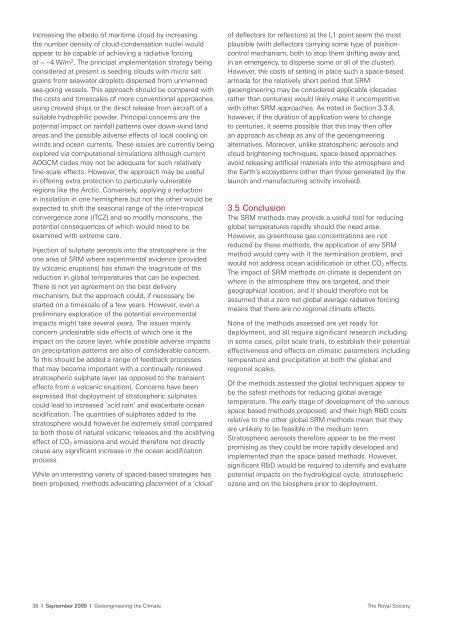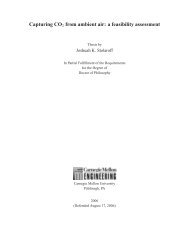Royal Society - David Keith
Royal Society - David Keith
Royal Society - David Keith
Create successful ePaper yourself
Turn your PDF publications into a flip-book with our unique Google optimized e-Paper software.
Increasing the albedo of maritime cloud by increasing<br />
the number density of cloud-condensation nuclei would<br />
appear to be capable of achieving a radiative forcing<br />
of ~ -4 W/m 2 . The principal implementation strategy being<br />
considered at present is seeding clouds with micro salt<br />
grains from seawater droplets dispersed from unmanned<br />
sea-going vessels. This approach should be compared with<br />
the costs and timescales of more conventional approaches<br />
using crewed ships or the direct release from aircraft of a<br />
suitable hydrophilic powder. Principal concerns are the<br />
potential impact on rainfall patterns over down-wind land<br />
areas and the possible adverse effects of local cooling on<br />
winds and ocean currents. These issues are currently being<br />
explored via computational simulations although current<br />
AOGCM codes may not be adequate for such relatively<br />
fine-scale effects. However, the approach may be useful<br />
in offering extra protection to particularly vulnerable<br />
regions like the Arctic. Conversely, applying a reduction<br />
in insolation in one hemisphere but not the other would be<br />
expected to shift the seasonal range of the inter-tropical<br />
convergence zone (ITCZ) and so modify monsoons, the<br />
potential consequences of which would need to be<br />
examined with extreme care.<br />
Injection of sulphate aerosols into the stratosphere is the<br />
one area of SRM where experimental evidence (provided<br />
by volcanic eruptions) has shown the magnitude of the<br />
reduction in global temperatures that can be expected.<br />
There is not yet agreement on the best delivery<br />
mechanism, but the approach could, if necessary, be<br />
started on a timescale of a few years. However, even a<br />
preliminary exploration of the potential environmental<br />
impacts might take several years. The issues mainly<br />
concern undesirable side effects of which one is the<br />
impact on the ozone layer, while possible adverse impacts<br />
on precipitation patterns are also of considerable concern.<br />
To this should be added a range of feedback processes<br />
that may become important with a continually renewed<br />
stratospheric sulphate layer (as opposed to the transient<br />
effects from a volcanic eruption). Concerns have been<br />
expressed that deployment of stratospheric sulphates<br />
could lead to increased ‘acid rain’ and exacerbate ocean<br />
acidification. The quantities of sulphates added to the<br />
stratosphere would however be extremely small compared<br />
to both those of natural volcanic releases and the acidifying<br />
effect of CO 2 emissions and would therefore not directly<br />
cause any significant increase in the ocean acidification<br />
process.<br />
While an interesting variety of spaced-based strategies has<br />
been proposed, methods advocating placement of a ‘cloud’<br />
of deflectors (or reflectors) at the L1 point seem the most<br />
plausible (with deflectors carrying some type of positioncontrol<br />
mechanism, both to stop them drifting away and,<br />
in an emergency, to disperse some or all of the cluster).<br />
However, the costs of setting in place such a space-based<br />
armada for the relatively short period that SRM<br />
geoengineering may be considered applicable (decades<br />
rather than centuries) would likely make it uncompetitive<br />
with other SRM approaches. As noted in Section 3.3.4,<br />
however, if the duration of application were to change<br />
to centuries, it seems possible that this may then offer<br />
an approach as cheap as any of the geoengineering<br />
alternatives. Moreover, unlike stratospheric aerosols and<br />
cloud brightening techniques, space-based approaches<br />
avoid releasing artificial materials into the atmosphere and<br />
the Earth’s ecosystems (other than those generated by the<br />
launch and manufacturing activity involved).<br />
3.5 Conclusion<br />
The SRM methods may provide a useful tool for reducing<br />
global temperatures rapidly should the need arise.<br />
However, as greenhouse gas concentrations are not<br />
reduced by these methods, the application of any SRM<br />
method would carry with it the termination problem, and<br />
would not address ocean acidification or other CO 2 effects.<br />
The impact of SRM methods on climate is dependent on<br />
where in the atmosphere they are targeted, and their<br />
geographical location, and it should therefore not be<br />
assumed that a zero net global average radiative forcing<br />
means that there are no regional climate effects.<br />
None of the methods assessed are yet ready for<br />
deployment, and all require significant research including<br />
in some cases, pilot scale trials, to establish their potential<br />
effectiveness and effects on climatic parameters including<br />
temperature and precipitation at both the global and<br />
regional scales.<br />
Of the methods assessed the global techniques appear to<br />
be the safest methods for reducing global average<br />
temperature. The early stage of development of the various<br />
space based methods proposed, and their high R&D costs<br />
relative to the other global SRM methods mean that they<br />
are unlikely to be feasible in the medium term.<br />
Stratospheric aerosols therefore appear to be the most<br />
promising as they could be more rapidly developed and<br />
implemented than the space based methods. However,<br />
significant R&D would be required to identify and evaluate<br />
potential impacts on the hydrological cycle, stratospheric<br />
ozone and on the biosphere prior to deployment.<br />
36 I September 2009 I Geoengineering the Climate The <strong>Royal</strong> <strong>Society</strong>








